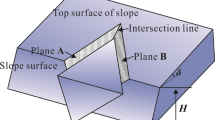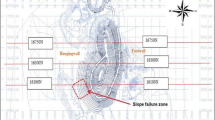Abstract
In performing kinematic wedge stability analysis, in practice, it is usually assumed that the wedge is a “Standard Wedge” (the term is explained in the paper) sliding along the line of intersection of the two discontinuity planes. Intersection of two discontinuities with the lower and upper rock slope surfaces can result in forming Standard Wedges, Overlying Wedges and No Wedges. Vector procedures are developed in the paper to differentiate the aforementioned formation modes for the wedges. Vector procedures are then given to calculate the sliding modes, sliding directions, maximum safe slope angles and factor of safety for the Standard and Overlying wedges. Procedures are also given to incorporate the variability of discontinuity orientations and strength and to calculate the instability cumulative probabilities corresponding to different cut slope dip angles. All these procedures are incorporated in a computer code, named PKWSAC. The developed procedure and the computer program were then validated by applying them to three examples and comparing the results obtained through this procedure with the results obtained through Lucas’ stereographic procedure [Lucas JM (1980) Int J Rock Mech Min Sci Geomech Abstr 17:57–61]. The validated procedure was then applied to a rock slope at a hydropower site in China to perform both deterministic and probabilistic kinematic wedge stability analyses. The paper also shows a comparison between the deterministic and probabilistic analyses results.










Similar content being viewed by others
Abbreviations
- CM:
-
Combination module
- CODS:
-
Combinations of discontinuity sets
- COTD:
-
Combinations of two discontinuities
- \( D_{i}\) :
-
Discontinuity i
- FM:
-
Formation mode: Standard Wedge, Overlying Wedge (D1-overlying-D2 Wedge or D2-overlying-D1 Wedge), No Wedge
- F s :
-
Factor of safety
- I 12 :
-
The vector along the LOI of planes 1 and 2
- \( \varvec{I}_{12}^{{\prime }} \) :
-
The downward vector along the LOI of planes 1 and 2
- KWSAM:
-
Kinematic wedge sliding analysis module
- LOI:
-
Line of intersection
- MOF:
-
Modes of failure: plane sliding, wedge sliding, and toppling
- MSSA:
-
Maximum safe slope angle
- n CODS :
-
Number of combinations of discontinuity sets
- n COTD-K :
-
Number of COTD from CODS K
- \({n_i} \) :
-
Number of discontinuities from set i
- \(\varvec{n_i} \) :
-
Upward unit normal vector of discontinuity or plane i, where i equals to 1, 2, and s for D 1, D 2, and P s
- \( \varvec{n}_{i}^{{\prime }} \) :
-
Unit normal vector of \( D_{i}\) pointing to interior of the formed wedge
- n xyi :
-
Projection of \(\varvec{n_i} \) on the horizontal plane
- PAM:
-
Probabilistic analysis module
- PKWSAC:
-
Probabilistic kinematic wedge sliding analysis code
- P s :
-
Slope face
- P(T):
-
Total cumulative probability obtained by PKWSAC
- P(T′):
-
Total cumulative probability obtained assuming all wedges are Standard Wedges and slide along LOI
- P wijm :
-
The instability probability with respect to WFM = W ij for cut slope dip angle m
- m :
-
Cut slope dip angle
- r :
-
Unit vector of resultant force
- S 1, S 2, S 12 :
-
Sliding along D 1, D 2, and LOI of D 1 and D 2, respectively
- s 1 , s 2 , s 12 :
-
The sliding directions of S 1, S 2, and S 12, respectively
- SM:
-
Sliding mode of a wedge, including single plane (S 1 and S 2) and double plane sliding (S 12)
- WFM:
-
Wedge failure modes
- \( x_{i},\, y_{i},\, z_{i}\) :
-
The components of \(\varvec{n_i} \) in (x, y, z) coordinate system
- \( x_{i}^{{\prime }},\, y_{i}^{{\prime }},\, z_{i}^{{\prime }}\) :
-
The components of \( \varvec{n}_{i}^{{\prime }} \) in (x, y, z) coordinate system
- β 12 :
-
The plunge of the LOI of D 1 and D 2
- γ 12l , γ 21k :
-
The angles of intersection of θ 1 and ψ 2l , and θ 2 and ψ 1k , respectively
- γ 12s :
-
Angle of intersection between the trend of LOI of D 1 and D 2 and the dip direction of the slope face
- γ ims , γ ips :
-
The angles of intersection of θ s and ψ im , and θ s and ψ ip , respectively
- δ i :
-
Dip angle of discontinuity or plane i, where i equals to 1, 2, and s for D 1, D 2, and Ps
- γ is :
-
The angle of intersection between the dip directions of D i and the slope face
- ε 12 :
-
The trend of the LOI of D 1 and D 2
- θ i :
-
Dip direction of discontinuity or plane i, where i equals to 1, 2, and s for D 1, D 2, and P s
- φ :
-
Friction angle
- ψ im , ψ ip :
-
The two directions of the strike of D i
- ψ i :
-
The direction of the strike of D i that intersects the strike of the slope face
References
Admassu Y, Shakoor A (2013) DIPANALYST: a computer program for quantitative kinematic analysis of rock slope failures. Comput Geosci 54:196–202
Ang AHS, Tang WH (1984) Probability concepts in engineering planning and design, vols I and II. Wiley New York
Baecher GB, Christian JT (2003) Reliability and statistics in geotechnical engineering. Wiley, New York
Carter BJ, Lajtai EZ (1992) Rock slope stability and distributed joint systems. Can Geotech J 29:53–60
Chen Z (2004) A generalized solution for tetrahedral rock wedge stability analysis. Int J Rock Mech Min Sci 41:613–628
Cruden DM (1978) Discussion of G Hocking’s paper ‘‘A method for distinguishing between single and double plane sliding of tetrahedral wedges’’. Int J Rock Mech Min Sci Geomech Abstr 15:217
Gokceoglu C, Sonmez H, Ercanoglu M (2000) Discontinuity controlled probabilistic slope failure risk maps of the Altindag (settlement) region in Turkey. Eng Geol 55:277–296
Goodman RE (1976) Methods of geological engineering in discontinuous rocks. West, San Francisco
Goodman RE (1989) Introduction to rock mechanics, 2nd edn. Wiley, New York
Goodman RE, Shi GH (1985) Block theory and its application to rock engineering. Prentice-Hall, Englewood Cliffs
Hocking GA (1976) A method for distinguishing between single and double plane sliding of tetrahedral wedges. Int J Rock Mech Min Sci 13:225–226
Hoek E, Bray JW (1981) Rock slope engineering, 3rd edn. Institute of Mining and Metallurgy, London
Jiang Q, Liu X, Wei W, Zhou C (2013) A new method for analyzing the stability of rock wedges. Int J Rock Mech Min Sci 60:413–422
Jimenez-Rodriguez R, Sitar N (2007) Rock wedge stability analysis using system reliability methods. Rock Mech Rock Eng 40(4):419–427
Kulatilake PHSW (1985) Fitting of Fisher distribution on discontinuity orientation data. J Geolog Educ 33:266–269
Kulatilake PHSW (1988) Minimum rock bolt force and minimum static acceleration in tetrahedral wedge stability: a probabilistic study. Int J Surface Mining 2:19–26
Kulatilake PHSW, Fuenkajorn K (1987) Factor of safety of tetrahedral wedges: a probabilistic study. Int J Surface Mining 1:147–154
Kulatilake PHSW, Shu B (2015) An approach to predict rock mass deformations in three dimensions for a part of an open pit mine and comparison with field deformation monitoring data. In: Proceedings of the 34th Ground Control Conference, Morgantown, West Virginia, USA, 28–30 July (in press)
Kulatilake PHSW, Wu TH (1984) Estimation of mean trace length of discontinuities. Rock Mech Rock Eng 17:215–232
Kulatilake PHSW, Wu TH, Wathugala DN (1990) Probabilistic modeling of joint orientation. Int J Numer Anal Methods Geomech 14:325–350
Kulatilake PHSW, Um J, Morin B (2003a) Investigation of slope stability for a section of Phelps Dodge Sierrita Open Pit Mine. Tran Soc Min Metall Explor 314:177–182
Kulatilake PHSW, Um J, Wang M, Escandon RF, Narvaiz J (2003b) Stochastic fracture geometry modeling in 3-D including validations for a part of Arrowhead East Tunnel site, California, USA. Int J Eng Geol 70(1–2):131–155
Kulatilake PHSW, Wang LQ, Tang HM, Liang Y (2011) Evaluation of rock slope stability for Yujian River dam site by kinematic and block theory analyses. Comput Geotech 38:846–860
Low BK (1997) Reliability analysis of rock wedges. J Geotech Geoenviron Eng 123:498–505
Lucas JM (1980) A general stereographic method for determining possible mode of failure of any tetrahedral rock wedge. Int J Rock Mech Min Sci Geomech Abstr 17:57–61
Markland JT (1972) A useful technique for estimating the stability rock slopes when the rigid wedge sliding type failure expected. Imp Coll Rock Mech Res Rep 19:1–10
Nilsen B (2000) New trend in rock slope stability analysis. Bull Eng Geol Environ 58:173–178
Öcal A, Ozgenoglu A (1997) Determination of sliding mode of tetrahedral wedges in jointed rock slopes. Rock Mech Rock Eng 30(3):161–165
Park HJ, West TR (2001) Development of a probabilistic approach for rock wedge failure. Eng Geol 59:233–251
Park HJ, West TR, Woo I (2005) Probabilistic analysis of rock slope stability and random properties of discontinuity parameters, Interstate Highway 40, Western North Carolina, USA. Eng Geol 79:230–250
Pathak S, Nilsen B (2004) Probabilistic rock slope stability analysis for Himalayan condition. Bull Eng Geol Environ 63:25–32
RockWare, ROCKPACKIII (2013). http://www.rockware.com/product/overview.php?id=119. Accessed 21 November 2013
Rocscience, DIPS (2013). http://www.rocscience.com/products/1/Dips. Accessed 21 November 2013
Sherizadeh T, Kulatilake PHSW (2015) Effect of geological and mining factors on roof stability of a room and pillar mine in US. In: Proceedings of the 34th Ground Control Conference, Morgantown, West Virginia, USA, 28–30 July (in press)
Sonmez H, Gokceoglu C (1998) A computer program for the kinematic analysis of rock slopes and its application. Earthsciences 20:75–89
Um J, Kulatilake PHSW (2001) Kinematic and block theory analyses for shiplock slopes of the Three Gorges Dam Site in China. Geotech Geol Eng 19:21–42
Wang YJ, Yin JH (2002) Wedge stability analysis considering dilatancy of discontinuities. Rock Mech Rock Eng 35(2):127–137
Wang YJ, Yin JH, Chen Z, Lee CF (2004) Analysis of wedge stability using different methods. Rock Mech Rock Eng 37(2):127–150
Wathugala DN, Kulatilake PHSW, Wathugala GW, Stephansson O (1990) A general procedure to correct sampling bias on joint orientation using a vector approach. Comp Geotech 10:1–31
Yoon WS, Jeong UJ, Kim JH (2002) Kinematic analysis for sliding failure of multi-faced rock slopes. Eng Geol 67:51–61
Acknowledgments
The work was partially funded by the Centers for Disease Control and Prevention (Contract No. 200-2011-39886), National Basic Research Program of China (973 Program; No. 2010CB732005) and the National Natural Science Foundation Project (No. 51079093). Jun Zheng is grateful to the Chinese Scholarship Foundation (No. CSC [2012] 3013) for providing a scholarship to conduct the research described in this paper as a Visiting Research Student at the University of Arizona.
Author information
Authors and Affiliations
Corresponding author
Rights and permissions
About this article
Cite this article
Zheng, J., Kulatilake, P.H.S.W., Deng, J. et al. Development of a probabilistic kinematic wedge sliding analysis procedure and application to a rock slope at a hydropower site in China. Bull Eng Geol Environ 75, 1413–1428 (2016). https://doi.org/10.1007/s10064-015-0764-3
Received:
Accepted:
Published:
Issue Date:
DOI: https://doi.org/10.1007/s10064-015-0764-3




